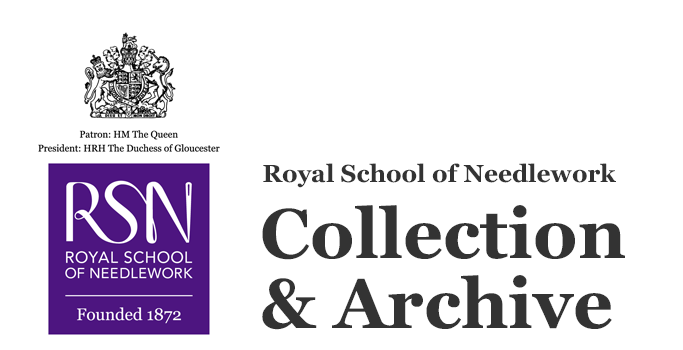Chalice veil
Object name
Date made
18th century
Place made
Description
18th-century Italian embroidered chalice veil with a quartet of floral arrangements and baskets holding fruits.
Content description
White silk satin chalice veil embroidered with silk and metal threads, made in Italy in the 18th century. The central motif is a decorative cross in the Avellane shape (derived from the appearance of husks of the plant corylus avellana or hazelnut). This is worked in gold passing threads which have been couched down and accompanied by matching foils. The cross is embellished with rays of the sun, also worked in gold passing thread. These represent the glory of Christ, emphasising His divinity and victory over death.
In each of the corners are baskets of fruits and flowers. The baskets are worked in gold passing thread using a basketweave pattern and have a scalloped edge. In between the basketweave pattern are rhombi of foils, which also adorn the bottom of each basket. Each of the baskets hold different fruits which include figs and plums worked in silk thread. The flowers are the same in each of the baskets and include carnations worked in pink silk, striped tulips in mauve and yellow silk, and anemones in shaded pink silk. The baskets are nestled on leaves and scrolls worked in silk and metal threads with small sprays of yellow and blue flowers. The flowers and fruits are worked in a combination of long and short stitch, satin stitch, and stem stitch. The veil is edged with metallic lace. The silk ground is shattered and, as a result, the entire piece has been conserved with a layer of netting.
During Eucharistic celebrations, a chalice veil is often used to cover the chalice and paten to keep dust and insects away from the bread and wine. Often made of opulent materials, chalice veils have not only a practical purpose, but are also intended to show honour to vessels used for the sacrament. This chalice veil, with its baroque floral imagery and central Christian imagery, is typical of 18th-century Italian examples.
In each of the corners are baskets of fruits and flowers. The baskets are worked in gold passing thread using a basketweave pattern and have a scalloped edge. In between the basketweave pattern are rhombi of foils, which also adorn the bottom of each basket. Each of the baskets hold different fruits which include figs and plums worked in silk thread. The flowers are the same in each of the baskets and include carnations worked in pink silk, striped tulips in mauve and yellow silk, and anemones in shaded pink silk. The baskets are nestled on leaves and scrolls worked in silk and metal threads with small sprays of yellow and blue flowers. The flowers and fruits are worked in a combination of long and short stitch, satin stitch, and stem stitch. The veil is edged with metallic lace. The silk ground is shattered and, as a result, the entire piece has been conserved with a layer of netting.
During Eucharistic celebrations, a chalice veil is often used to cover the chalice and paten to keep dust and insects away from the bread and wine. Often made of opulent materials, chalice veils have not only a practical purpose, but are also intended to show honour to vessels used for the sacrament. This chalice veil, with its baroque floral imagery and central Christian imagery, is typical of 18th-century Italian examples.
Dimensions
width: 64cm
height: 66cm
height: 66cm
Materials
Stitches
Techniques
Motifs
Catalogue number
COL.80
Other numbers
RSN 999
© Royal School of Needlework

